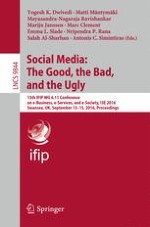2016 | Buch
Social Media: The Good, the Bad, and the Ugly
15th IFIP WG 6.11 Conference on e-Business, e-Services, and e-Society, I3E 2016, Swansea, UK, September 13–15, 2016, Proceedings
herausgegeben von: Yogesh K. Dwivedi, Matti Mäntymäki, M.N. Ravishankar, Marijn Janssen, Marc Clement, Emma L. Slade, Nripendra P. Rana, Salah Al-Sharhan, Antonis C. Simintiras
Verlag: Springer International Publishing
Buchreihe : Lecture Notes in Computer Science
